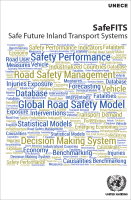Road accidents constitute a major social problem in modern societies, accounting for more than 1 million accidents per year in EU-28 (2,900 per day), resulting in 1.4 million injuries and 26,000 fatalities (70 per day) (WHO, 2015). Road traffic injuries are estimated to be the eighth leading cause of death globally, and more than half of the people killed in traffic accidents are young adults aged between 15 and 44 years. In low- and middle-income countries, the rates of road traffic injuries are twice those in high-income countries and still increasing. This can be partly attributed to rapid motorization in many developing countries, without any investment being made in road safety. Current trends suggest that, unless action is taken, traffic injuries will become the fifth leading cause of death by 2030, with the disparity between high- and low-income countries further increased (WHO, 2015).
SafeFITS model
The SafeFITS model consists of several components:
- SafeFITS database with data on road safety indicators (fatalities and injuries, performance indicators, road safety measures, economy and background) for all countries, which were used for the estimation of new global causalities, through the development of statistical models.
- SafeFITS set of statistical models of global causalities, estimated on the basis of the database of road safety indicators, allowing intervention, forecasting and benchmarking analyses within SafeFITS.
- SafeFITS tool, including three complementary modules, all serving very common purposes in road safety policy analysis:
- An intervention analysis module, to allow the user to forecast the safety effects of a specific road safety measure or intervention for a given country and time period, all other things being kept constant.
- A forecasting module, to allow the testing of combined scenarios of interventions (measures and programmes) at national level.
- A benchmarking module,to allow the user to benchmark a country against other countries, by comparing the road safety outcomes in relation to the basic road safety indicators, and by identifying the priority areas that the country should focus on for improving its road safety.
The SafeFITS Project was implemented with the financial support from the International Road Transport Union (IRU).
- Events
-
SafeFITS Round Table, Geneva, 30 June 2017
PDF Safe Future Inland Transport Systems (E. Molnar, Director, UNECE)
PDF SafeFITS - A Global Road Safety Model For Future Inland Transport Systems (Prof. G. Yannis, NTUA)
PDF SafeFITS Web Application: Architecture and User Interface (Prof. C. Antoniou, TUM)
PDF Reliable statistics - A key for better road safety policy (N. Menton, UNECE)
PDF WHO road safety data collection experience (Dr. K. Iaych, WHO)
PDF Measuring Road Safety Performance (D. Cliff, Global Road Safety Partnership)
PDF The role of road safety indicators in policy - SafeFITS Round Table (G. Jost, European Transport Safety Council)
PDF Road Safety Practice by ADB (Ki-Joon Kim, Asian Development Bank)
Working Party on Road Traffic Safety, 75th session, Geneva, 19 - 22 September 2017PDF SafeFITS - A Global Road Safety Model For Future Inland Transport Systems (Prof. G. Yannis, NTUA)
Developing a Global Road Safety Model Presentation (Prof. G. Yannis, NTUA)
The TRB 97th Annual Meeting, Washington, DC, 7 - 11 January 2018
Developing a Global Road Safety Model Poster (Prof. G. Yannis, NTUA) - User manual
-
Relevant documentation, including details on the methodology behind the modelling approach; the model structure, giving information on each calculation step; the input data required, including explanations on how to use the input file; and instructions on how to perform model runs, illustrating how to visualize the results are available in the user manual.
For further instructions on the use of the SafeFITS model and information on its characteristics, please contact UNECE directly (see the contact tab). - Reports
-
After the completion of the final phase of the project at the end of 2017, a final report was developed which provides a literature review as well as detail on how the model was developed and can be used.
This report presents the results of the project Safe Future Inland Transport Systems (SafeFITS), which aims to develop a robust road safety decision-making tool to support the most appropriate road safety policies and measures to achieve tangible results.
The SafeFITS tool is composed of three complementary modules: Intervention analysis: allows the user to examine the effects of single interventions at national or country cluster level. Forecasting analysis: allows the user to define own scenarios of measures (or combinations of measures) in a country and obtain medium/long term road safety forecasts for each scenario. Benchmarking analysis: allows the user to benchmark a country against a group of countries (e.g. all countries, countries of similar economic or road safety performance).
The present report includes an indicative demonstration of the model implementation within SafeFITS web-based tool, by means of wire-frames presentation. The model may provide forecasting and benchmarking estimates for 130 countries: Base case scenario, solely on the basis of GNI projections (either official projections, or user-defined). This scenario serves as a reference case for assessing the effects of interventions. Policy scenarios with up to a maximum of eight interventions, in addition to GNI developments. This allows one to assess the cumulative impact of these interventions on the forecasted road safety outcomes, and the country’s position globally or within its country cluster. - Contacts
-
Nenad NikolicSustainable Transport DivisionUnited Nations Economic Commission for Europe
[email protected]


